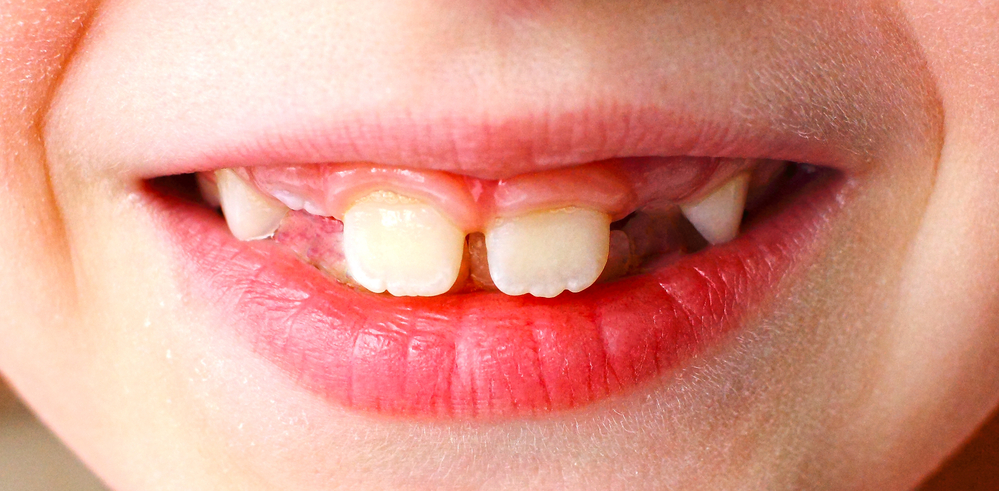
Traditionally, orthodontic treatment begins when a child has lost most of his or her baby (primary) teeth, and a majority of the adult (permanent) teeth have grown in. This usually occurs between the ages of 8 and 14 for most children. Preventative measures can be taken during your child’s growth to help guide the development of their smile.
An interceptive approach, typically involving dental appliances at an earlier age, can be used if children still have most of their baby teeth.
Early Clues Your Child Is Ready For Braces
The gums hide about ⅔ of each tooth, as well as all of the bone that holds each tooth in place. Parents can watch for clues or early indications that a child may need braces or if they’re ready for braces. Early or late loss of baby teeth can sometimes signal a potential problem, in addition to difficulty chewing or biting, speech difficulties, and mouth-breathing.
An orthodontist should see a child experiencing these indications. If these issues are left unaddressed until a child has all of his/her permanent teeth, correcting the issues may be more difficult. Early intervention is key in orthodontics, and the following are common indications that your child may be ready for braces.
If Your Child Has Lost Most of Their Baby Teeth
While it’s not necessary to wait for adult teeth to grow in fully, most dentists and orthodontists prefer to wait for most baby teeth to fall out before braces are put on. If your child has lost most of their baby teeth with only one or two left, it may be the perfect time to plan their orthodontic treatment plan. A consultation exam with an orthodontist can be performed as soon as the first adult teeth begin to come in. An orthodontist can then monitor the loss of your child’s baby teeth and provide you with an accurate timeline for your child’s orthodontic treatment plan and when it’s the best time to have braces put on.
If Your Child’s 12 Year Molars Are Erupting
Most children’s 12-year molars start to slowly erupt between the ages of 10 and 13 years old. Most orthodontists prefer to wait until these molars are at least partially erupted before placing brackets and wires. This is because the molars may be closer to other teeth or even larger than expected. If this is the case, these teeth can push on teeth in the mouth, and they may also fill in gaps naturally. If braces are placed before these molars come in, it can lead to overcrowding, and the teeth can start to shift.
If Your Child’s Teeth Are In Danger of Permanent Damage
Abnormalities that push adult teeth to the point of being damaged indicate that orthodontic intervention is necessary. If your child’s teeth are severely crowded, crossed over one another, or if your child has an extreme overbite, braces can be placed as early as age seven. If your child starts their orthodontic treatment at an early age, their treatment plan may be expensive. In some severe cases, a child may need braces at two different points in their life to prevent damage to permanent adult teeth.
Creating a Healthy Smile With Orthodontics
The orthodontic treatment goal is to make sure that the bite is right and that the upper and lower teeth fit together like interlocking gears. The timing of your child’s treatment is critical and is based on his/her individual needs. Some children can wait until they have all or most of their permanent teeth. Other children’s orthodontic problems may be better treated with phase one orthodontics while some baby teeth are present. These children require growth guidance of bones in the upper and lower jaws, so there’s enough room for permanent teeth. Their treatment can be timed to predictable stages of dental development and physical growth. Once the teeth and jaws are in proper alignment, a beautiful smile is the bonus result of treatment.
Schedule an Orthodontic Evaluation By Age 7
The American Association of Orthodontists (AAO) recommends that children be seen for their first orthodontic evaluation no later than age 7. If an issue is detected early, treatment can be advised to allow the orthodontist to correct the issue before it becomes more severe.
During an orthodontic evaluation, you will have the opportunity to ask questions about future treatments and if your child will need braces in the future to correct any problems. If you suspect an issue with your child’s bite, even if your child is younger than 7, contact Thomas Orthodontics today.





